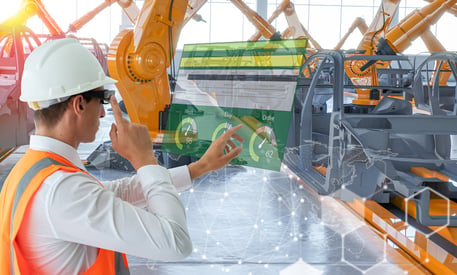Wearable technology has exploded over the past few years.
From fitness trackers to smartwatches, we’ve seen the rise of new wearable electronic devices that allow us to do amazing things in our life and the workplace.
Wearable applications, however, aren’t just limited to health applications anymore.
Manufacturers are now using these devices to make their operations more efficient. This means that manufacturers can get a lot more information from their factories without having to send someone down every time something goes awry.
In this article, we are going to look out how wearable technology is revolutionizing the workplace, examples and its benefits.
Wearable Technology is Revolutionizing Safety
Wearable technology is revolutionizing workplace safety in industrial settings.
From monitoring workers during hazardous tasks on the field or manufacturing floor to alerting them to dangerous conditions, wearable tech is helping employers keep their workforce safe and efficient.
The tools help employers monitor workers throughout the day, providing real-time field communication and allowing managers to respond quickly to issues, thus ensuring worker safety.
For example, if an employee notices that he or she has been exposed to harmful chemicals, they can immediately notify management who can then take action to ensure the situation doesn’t escalate into a larger problem.
Another example of wearable technology improving workplace safety is for preventing injuries.
If you work on a factory floor, chances are you know all too well about the dangers associated with working at heights.
But what if your employer could use wearable technology to prevent accidents like falls by tracking body movements and sending alerts if the worker moves erratically?
These types of solutions are becoming increasingly popular as companies realize the benefits of using wearables to improve safety and efficiency.
Wearable Technology is Revolutionizing Manufacturing Operations
Wearable technology is also transforming manufacturing operations.
By collecting data from various sensors, wearable tech allows manufacturers to gain insight into how their processes operate.
This helps them identify areas where there may be room for improvement.
For instance, if a manufacturer finds certain machines are operating slower than expected, they can determine why this is occurring and find ways to increase production while reducing costs.
Wearable technology is even being used to collect data from products themselves.
Some manufacturers are using IoT (Internet of Things) technology to gather data directly from their products.
This allows them to see exactly how their products are performing and whether they need any adjustments before shipping.
 Examples of Industrial Wearables
Examples of Industrial Wearables
There’s a wide range of wearable devices designed for manufacturing and logistics environments. Let’s have a look at some industrial wearable examples:
- Smart glasses
Smart glasses can help workers see information on their screens without having to take off their eyewear.
Smart glasses can also display alerts and warnings that would normally go unnoticed.
For example, if there is an emergency, smart glasses could alert users to danger. Other examples include displaying safety instructions and providing directions.
Smart glasses can even monitor worker performance. For example, we can program them to measure the time spent looking away from the screen.
Besides monitoring human motion, smart glasses can also collect data. They can record temperature, humidity, air pressure, and more.
Companies can connect smart glasses to computers via Bluetooth or Wi-Fi. This allows them to communicate with other devices and share data.
- Wearable Computers
A wearable computer can be defined as a device worn on the body that provides computing power.
These devices usually contain a microprocessor, input/output (I/O) and memory capabilities.
They may also include a touch interface, camera, microphone, speaker, GPS receiver, accelerometer, gyroscope, compass, and barometric sensor.
Wearable computers can be used for many purposes. For instance, they can control machinery, track inventory, or monitor health conditions.
Sometimes, wearable computers are worn by a user on their body and provide information about the environment in which the wearer is located.
- Hands Free Order Picker
The logistics industry is not new to wearable technology. But there had been new smart technology that emerged over the years.
An order picking solution is a handheld device used to retrieve items from storage locations. It is typically used in warehouses and distribution centers.
The order picker can be equipped with various sensors to detect when it is near objects or people. These sensors allow the order picker to navigate through its workspace safely and efficiently.
Order pickers can be operated using voice commands or touchscreen controls.
Voice recognition technology can be integrated into the order picker so that it can recognize orders and respond accordingly.
This helps prevent errors and increases productivity.
- Wearable Sensors
Wearable sensors can monitor workers’ activities during the day.
Wearable sensors have been incorporated into smart clothing, hats, watches, rings and other easy-to-wear-styles.
Some of these wearable technologies measure health parameters such as heart rate, blood oxygenation, breathing patterns, and brain activity. It is also designed to monitor environmental factors, such as light intensity and temperature.
Wearable sensors also make it easier to collect accurate data on the manufacturing floor. For example, a sensor that can measure the temperature of an entire room or the humidity in a factory could track how well workers are performing their jobs and whether they need additional training or equipment.
Wearable Technology Could Be Your Next Step Towards A More Efficient Future
In conclusion, wearable industrial devices have been around for decades but only recently gained traction. While most wearables still feel like science fiction, the technology behind them continues to improve. As such, companies should be aware of the growing demand for products that use sensors and data analytics to monitor workers’ health and performance. To ensure their employees remain productive, employers must look beyond traditional solutions and consider new smart technologies that will provide them with real value.
To learn more about how Radwell International can support your manufacturing operation

